
Tea farming often conjures up images of peaceful, verdant fields. However, the reality behind those tranquil scenes is a desperate need for water, a resource that is quickly dwindling. This is where solar irrigation systems come in. They offer a sustainable solution that could change the way we cultivate tea. It’s not just about maintaining the greenery of the fields, but doing so in a responsible, efficient manner that ensures the longevity of tea farming for future generations.
First and foremost, we’re considering a solution that is advantageous to both the earth and the farmer. Solar irrigation combines the sun’s free energy with the vital power of water, resulting in a cycle that is as advantageous as it is aesthetically pleasing. This isn’t just agriculture; it’s intelligent agriculture, and it’s a route that every environmentally conscious farmer should consider taking.
Key Takeaways
Solar irrigation systems use the sun’s energy to power water pumps, reducing dependence on fossil fuels and electricity.
These systems can dramatically reduce water usage by delivering it directly to the plants’ roots.
While initial costs may be higher, long-term savings on energy and water bills make solar irrigation a financially sound choice.
Using solar power for irrigation can improve tea yield and quality by providing consistent and adequate watering.
Adopting solar irrigation supports sustainable farming practices, helping to protect the environment and conserve resources.
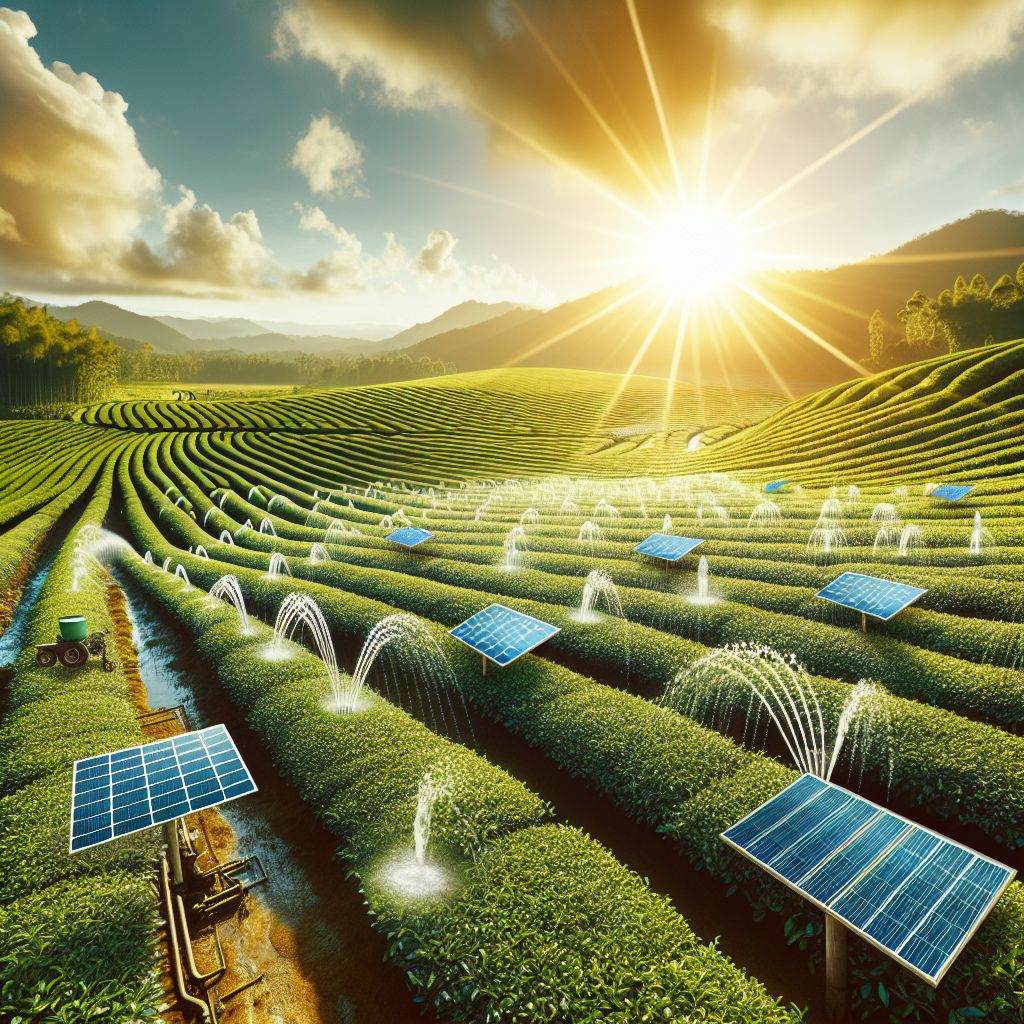
Why Combine Solar Panels with An Irrigation System
Imagine a world where the sun doesn’t just warm the soil; it also waters it. That’s what solar irrigation is all about. By using solar energy to power irrigation systems, we’re tapping into an unlimited energy source that’s always available. This isn’t just cutting-edge; it’s the edge we need to stay ahead in sustainable farming.
Sunshine: More Than Just Light
The sun does more than just shine; it powers. Harnessing its energy through solar panels allows us to operate water pumps without needing any fuel or creating any emissions. This is the epitome of clean energy – and it’s plentiful, especially in areas where tea grows best.
Accurate Water Distribution
Solar irrigation isn’t about haphazardly watering and hoping it works out. It’s about giving the tea plants the exact amount of water they need, exactly when they need it. This focused method makes every drop matter, cutting down on waste and making sure the plants are properly watered without over or under watering.
Increasing Production
Regular and sufficient watering can result in a considerable increase in tea production and quality. Solar irrigation systems provide that regularity, powered by the most dependable star in our galaxy. This is how we satisfy the increasing demand for tea without sacrificing quality or sustainability.
It’s a Double Victory
Adopting solar irrigation is not only a victory for the environment but also a victory for the farmer’s wallet. Lower energy bills and water savings are significant, and the long-term financial benefits are as clear as the sun. This is an investment in the future, and the returns are both green and gold.
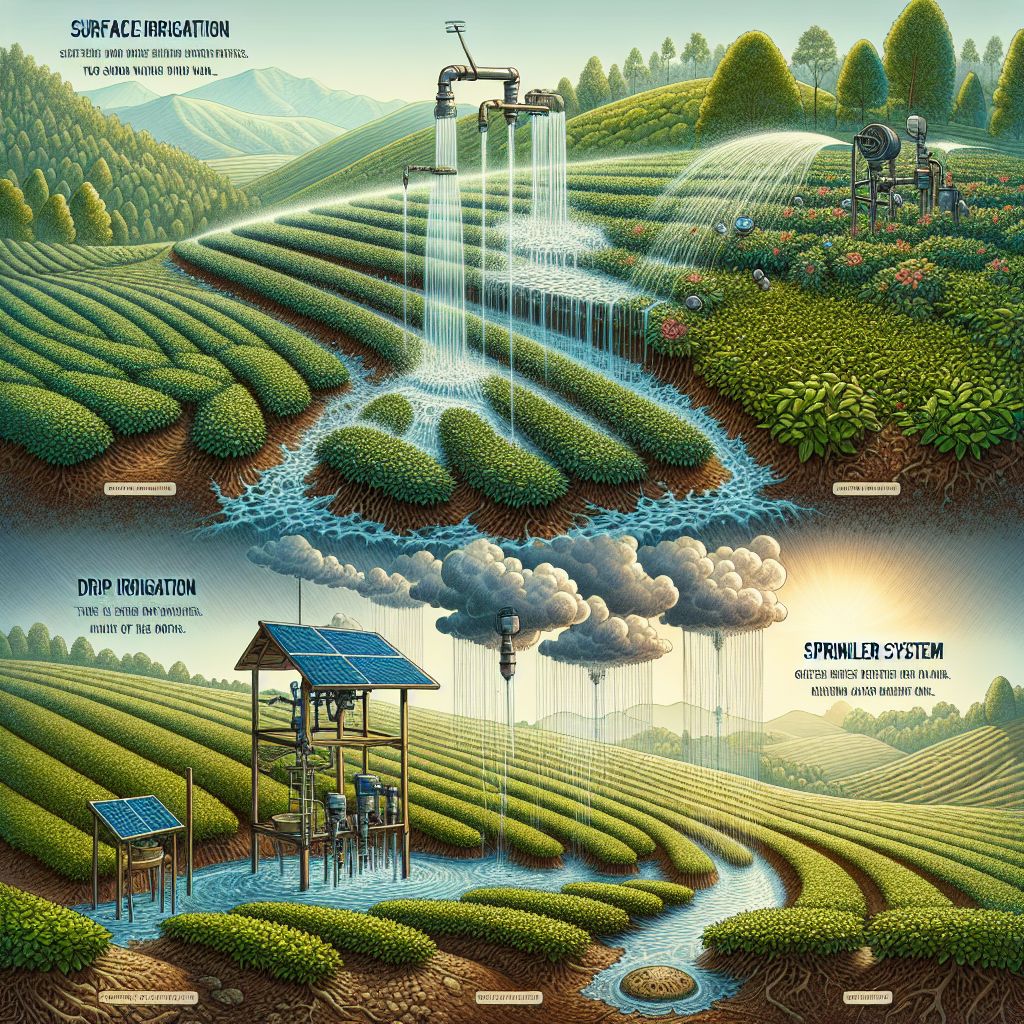
Various Watering Systems for Tea Cultivation
Tea plants are similar to humans; they require water to survive. But, akin to humans, they don’t all necessitate the same quantity. That’s the reason there are various watering systems designed to meet the distinct requirements of tea farms. Let’s delve into the systems that maintain these plants in their prime condition.
The Good and Bad of Surface Irrigation
Surface irrigation is comparable to the traditional watering can – it’s easy and gets the job done. The water flows over the ground and seeps into the soil, nourishing the roots of the plants. But, just like the watering can, it lacks precision and can result in a significant amount of wasted water. Here are the details:
Advantages: It’s affordable and simple to set up.
Disadvantages: It can cause waterlogging and uneven water distribution.
Drip Irrigation: Increasing Water Use Efficiency
Now, let’s discuss drip irrigation. Imagine it as the careful gardener who waters each plant with attention. Drip irrigation provides water directly to the base of the tea plants, drop by drop. This system is a turning point for water efficiency and here’s why:
Every drop of water is used efficiently, reducing evaporation and runoff.
It lowers the chances of diseases that can grow in overly damp conditions.
It enables specific watering schedules, customized to the plants’ requirements.
But that’s not all. Drip irrigation can be effortlessly combined with solar pumps, offering a smooth and environmentally friendly watering solution. Emitters are used to slowly release water to the plant roots, giving just the right amount of hydration without waste. It’s a more intelligent way to water, and the tea plants adore it.
Sprinkler Systems: The Perfect Fit for Larger Tea Estates
Think of sprinkler systems as your own personal rainclouds. They are capable of covering large areas, which makes them a perfect fit for larger tea estates. They work by spraying water over your fields, just like a light rain shower. However, they may not be as efficient as drip systems because some water may evaporate or be carried away by the wind.
However, if they are solar-powered, sprinkler systems can still contribute to a sustainable irrigation strategy. They offer a wide and consistent water distribution, which can be particularly useful during dry periods. And they save time and labor when they are automated.
Next, we will take a closer look at the financial aspects of these systems and explore how solar energy can shift the balance on irrigation expenses.

The Efficiency of Traditional Versus Advanced Irrigation Systems for Growing Tea
Irrigation is an essential part of tea cultivation, and the choice of irrigation system can significantly impact the cost and efficiency of production. Traditional irrigation systems, such as furrow irrigation and overhead sprinklers, have been used for centuries, but advanced irrigation systems, such as drip irrigation and micro-irrigation, have become increasingly popular in recent years.
Traditional Irrigation Systems
Traditional irrigation systems are typically less expensive to install and maintain than advanced irrigation systems. Furrow irrigation involves flooding the field with water, while overhead sprinklers spray water over the crop. These systems can be effective in providing water to the crop, but they can also be inefficient, as water can be lost to evaporation or runoff.
Advanced Irrigation Systems
Advanced irrigation systems, such as drip irrigation, deliver water directly to the roots of the plants. This can result in significant water savings, as there is no evaporation or runoff. Advanced irrigation systems can also be automated, which can save labor costs. However, these systems can be more expensive to install and maintain than traditional irrigation systems.
Cost Comparison
The cost of an irrigation system will vary depending on the size of the field, the type of system chosen, and the local labor costs. In general, traditional irrigation systems are less expensive to install and maintain than advanced irrigation systems. However, the long-term cost of ownership may be lower for advanced irrigation systems, as they can save water and labor costs.
Efficiency Comparison
Advanced irrigation systems are more efficient than traditional irrigation systems. Drip irrigation can deliver water directly to the roots of the plants, which results in less water loss to evaporation or runoff. These systems can also be automated, which can save labor costs.
The choice of irrigation system for growing tea depends on a number of factors, including the size of the field, the type of crop, the local climate, and the available budget. Traditional irrigation systems are less expensive to install and maintain, but they can be less efficient than advanced irrigation systems. Advanced irrigation systems can save water and labor costs, but they can be more expensive to install and maintain. Growers should carefully consider all of these factors when choosing an irrigation system for their tea plantation.
Now, let’s switch topics and discuss the solar panels themselves – the core of any solar irrigation system.
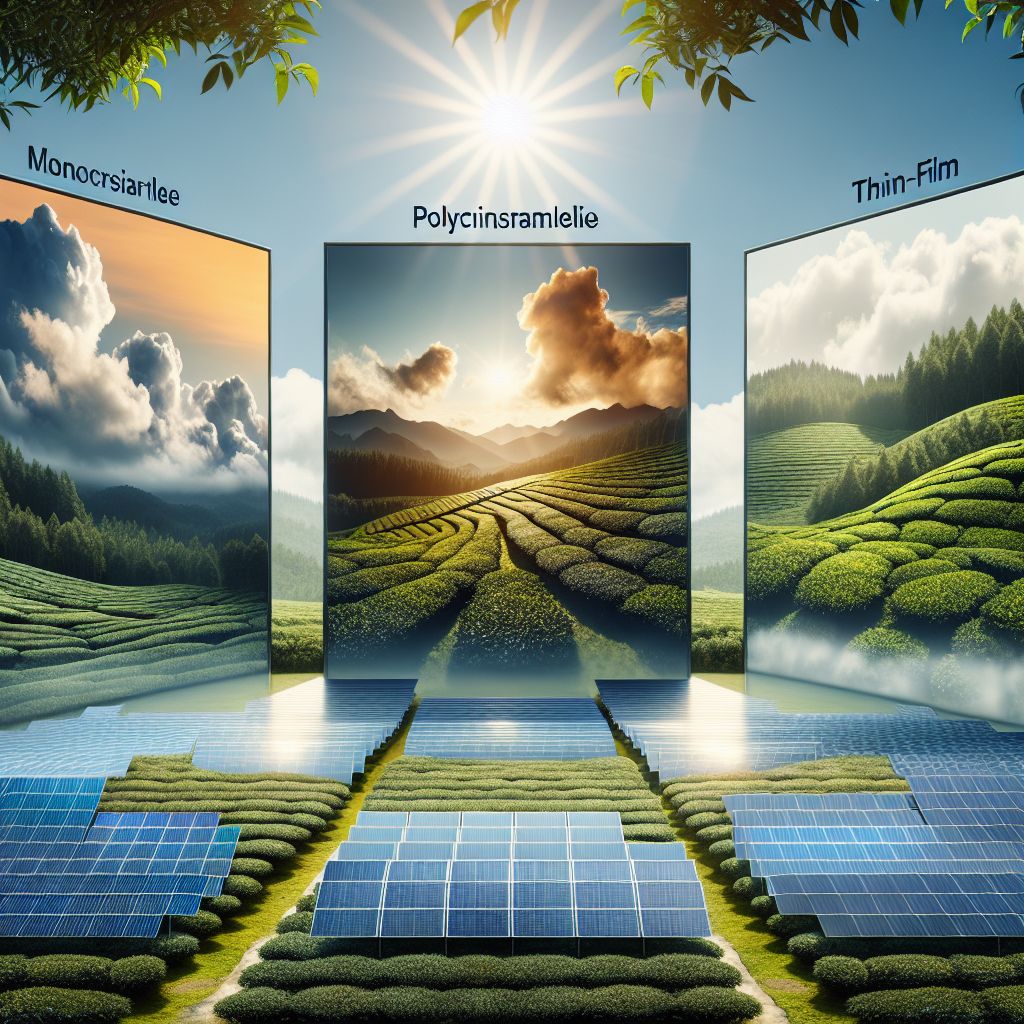
Picking the Best Solar Panels for Your Tea-Growing Irrigation System
Selecting the right solar panels is as important as choosing the best seeds for your crops. There are several types of panels to consider, each with their own strengths and ideal conditions. Here’s a quick guide to help you make the best choice.
Monocrystalline Solar Panels: Are They Right for Tea Farms?
Monocrystalline panels are the Ferraris of solar panels. They’re slick, efficient, and they run well even when the sun isn’t at its brightest. For tea farms, which might not always be in direct sunlight, these panels are a dependable option.
While they may be more expensive, they also typically have a longer lifespan and offer a greater power output. If you’re considering the long-term – and as a farmer, you should always be doing this – monocrystalline panels are a good investment.
For instance, a tea farm in an area with unpredictable weather decides to use monocrystalline panels. Even on the rare cloudy day, the farm’s solar irrigation system operates without a hitch, ensuring the tea plants are watered exactly when they need it.
Polycrystalline Solar Panels: Budget-Friendly Choices
Polycrystalline panels are the dependable, hard-working option in the solar panel universe. They might not be as efficient as monocrystalline panels, but they’re also less expensive. If your tea farm has a lot of sun exposure and you’re on a tight budget, these panels can provide the necessary power without causing financial strain.
They also require less energy to manufacture, making them more environmentally friendly. The less energy used, the smaller the carbon footprint, which is something we can all appreciate.
Thin-Film Solar Panels: The New and Flexible Solution
Thin-film solar panels are the latest addition to the solar panel family. They’re not as heavy as their counterparts, and they can bend, making them suitable for a wide range of applications. They may not be as efficient as monocrystalline or polycrystalline panels, but their adaptability compensates for this. For more insights on how solar technology is being used on farms, check out our article on solar panel applications for farms.
If you have a tea farm with non-traditional surfaces for mounting, such as curved roofs or structures, these panels are especially beneficial. They’re also a great option if you’re looking for something that can be easily moved around.
|
Solar Panel Type |
Efficiency Range |
Advantages |
Disadvantages |
|---|---|---|---|
|
Monocrystalline |
17-22% |
Highest efficiency, space-saving, long lifespan. 2 | |
|
Polycrystalline |
15-17% |
Lower efficiency, requires more space. 2 | |
|
Thin-Film |
10-13% |
Lightweight, flexible, good temperature coefficient. 2 |
Lowest efficiency, requires large area. 2 |
|
Portable Solar Panel Systems |
Varies based on panel type |
Designed for irrigation needs, easy to move and relocate. 1, 3 | |
|
Hybrid Solar Panels |
Varies based on components |
Can combine solar with other energy sources like wind, increased reliability. 4 |
More complex system, higher cost. 4 |
Monocrystalline panels provide the highest efficiency in a compact area but at a higher upfront cost (2, 3). Polycrystalline panels offer a balance of efficiency and cost (2, 3). Thin-film panels have lower efficiency but perform better in high temperatures (2). Portable solar panel irrigation systems allow flexibility in placement and relocation as needed (1). Hybrid systems increase reliability by combining solar with other renewable sources but add complexity (4). The optimal choice depends on factors like available space, budget, local climate conditions, and specific irrigation requirements for tea.
Getting the Best Out of Your Solar Panels with Proper Placement and Orientation
To maximize the efficiency of your solar panels, you need to position them where they can absorb as much sunlight as possible. This means pointing them south if you’re in the Northern Hemisphere, and north if you’re in the Southern Hemisphere. The tilt of the panels is also crucial; it should be the same as your latitude to directly face the sun.
Keep in mind, the more sunlight your panels get, the more water your solar pumps can distribute. It’s all about setting yourself up for success – quite literally.
Next, we’ll compare the efficiency and costs of traditional irrigation systems with those that use solar power.
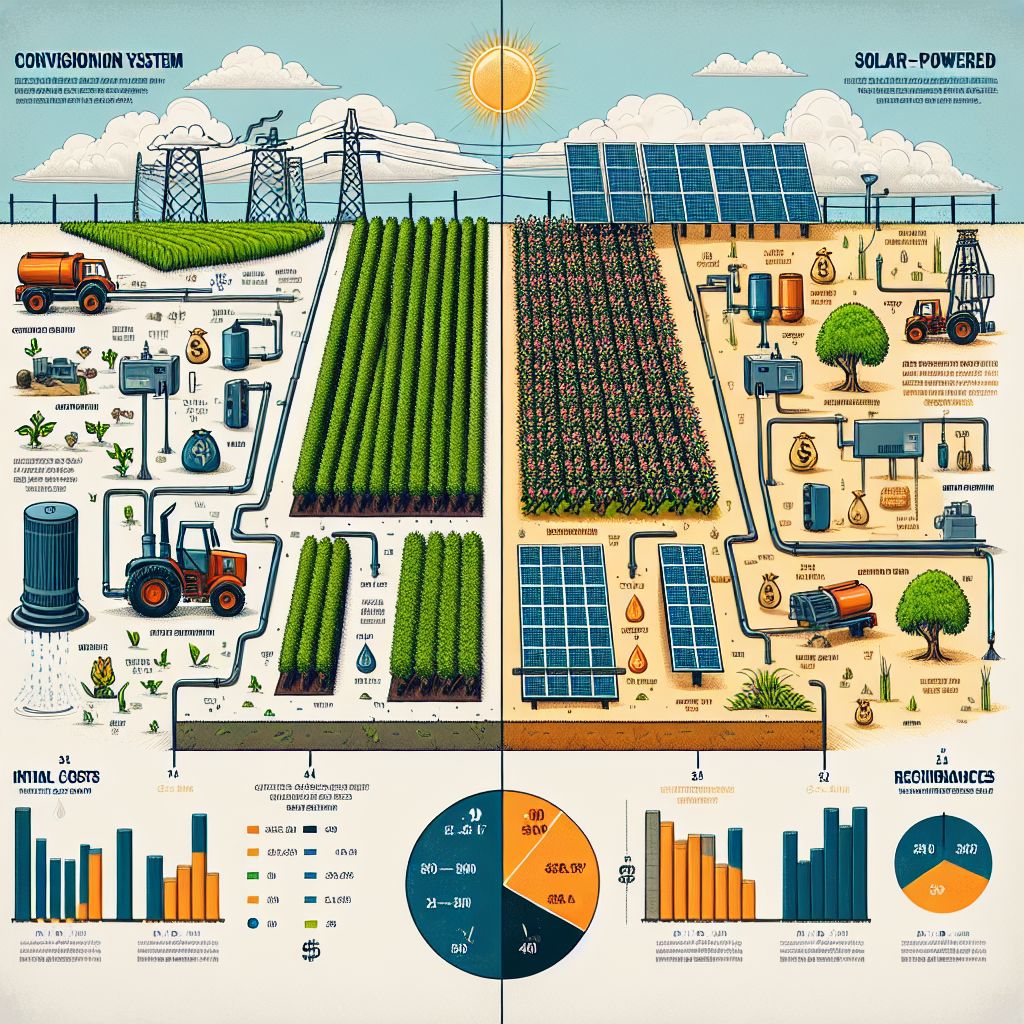
Comparing the Costs and Efficiency of Traditional to Solar Irrigation Systems
When it comes to farming, every penny counts. Traditional irrigation systems have been the backbone of farming for many years, but they come with ongoing costs that can strain your budget. It’s like renting an apartment; you’re paying every month for something that will never be yours. Solar irrigation systems, however, are like buying a house; there’s an initial cost, but eventually, it pays for itself and you’re living rent-free.
Understanding the Operating Expenses for Conventional Systems
Conventional irrigation systems rely on electricity or diesel to power the pumps, and the expenses can accumulate over time. For example, a diesel pump could cost you approximately $0.20 to $0.30 per kWh, whereas grid electricity might range from $0.10 to $0.30 per kWh, based on your location. Although these expenses may appear minor initially, they can total to thousands of dollars over the course of a year.
Why Choose Solar Irrigation Systems: A Closer Look Effect on Crop Yield and Tea Quality
Let’s take a moment to appreciate solar irrigation systems. They tap into the sun’s energy, which is essentially limitless and free. Of course, there’s maintenance to think about, but it’s nothing compared to the fuel and electricity expenses of old-school systems. Plus, with solar panels and batteries becoming more affordable and effective, the upfront cost isn’t as daunting as before.
Let’s put this into perspective with a quick comparison. This table compare the pros and cons of conventional irrigation systems and solar-powered irrigation systems:
|
Aspect |
Conventional Irrigation System |
Solar-Powered Irrigation System |
|---|---|---|
|
Pros |
No ongoing energy costs, uses free solar power. 5 | |
|
Simple installation and maintenance. 1 |
Environmentally friendly, reduces carbon footprint. 3 | |
|
Reliable water supply even during power outages. 5 | ||
|
Long lifespan of solar panels (25-30 years). 5 | ||
|
Cons | ||
|
Susceptible to power outages. 5 |
Requires some technical knowledge for installation/maintenance. 3, 4 | |
|
Environmental impact from energy use. 3 |
Risk of over-abstraction of groundwater if not managed properly. 3, 4 | |
|
Potential for water waste/inefficiency. 1 |
Effect on Crop Yield and Tea Quality
However, it’s not just about the expense; it’s also about the yield and the quality. A solar-powered irrigation system provides a steady and reliable supply of water, which is essential for tea plants. They’re susceptible to water stress, and even minor changes can impact the quality of the tea leaves. By providing a consistent supply of water, solar-powered irrigation can result in a higher yield of higher-quality tea. And that translates to better business.
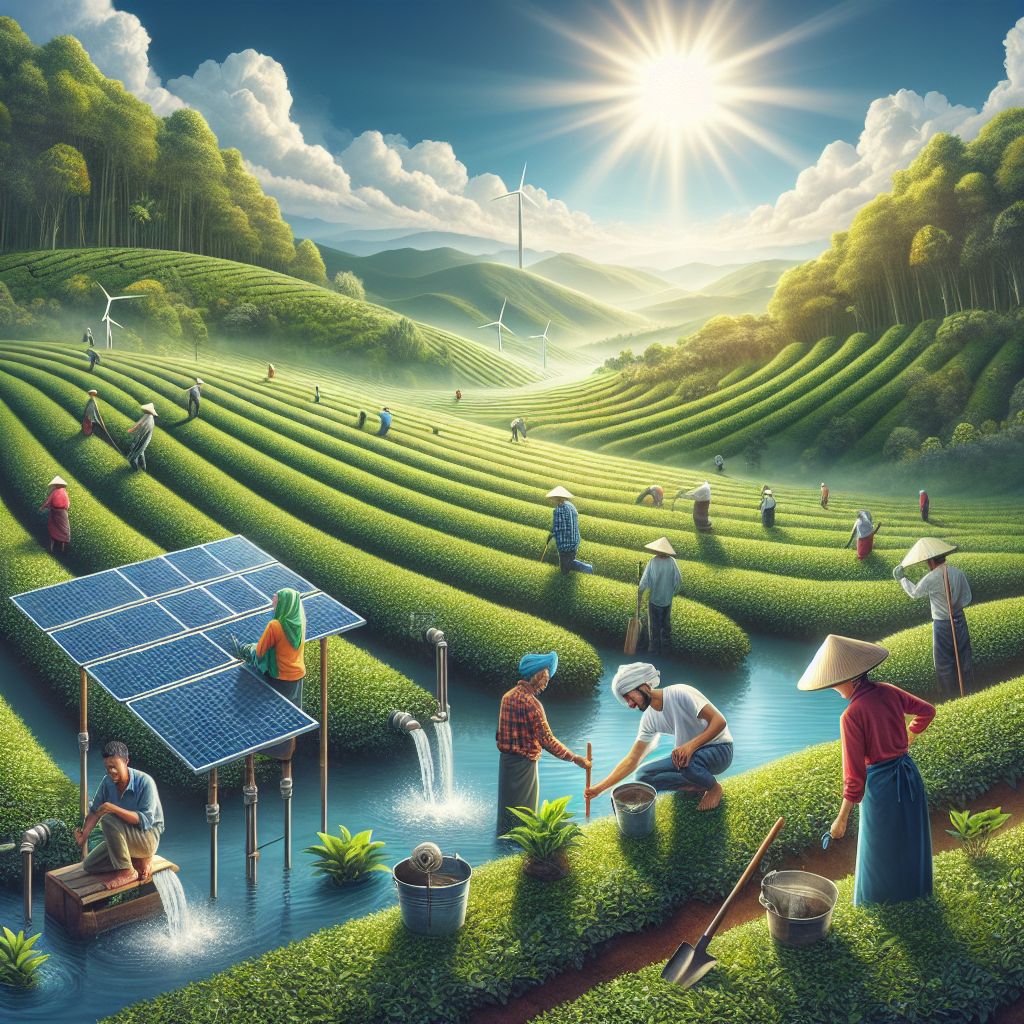
Final Thoughts:
Why Tea Farmers Should Make the Switch to Solar Irrigation
Moving to solar irrigation is not just a wise economic decision; it’s a pledge to sustainable farming. It’s about making sure that the peaceful tea landscapes we know and love are safeguarded for the generations to come. By adopting solar irrigation, farmers can lower their carbon emissions, save water, and create a more robust business.
Final Remarks on the Adoption of Solar Irrigation for Tea Cultivation
As Farmers, we are stewards of the earth, and it is our responsibility to make choices that will preserve it. Solar irrigation is one such choice. It’s an effective method to care for our crops and our planet at the same time. So let’s utilize the sun, let’s irrigate our tea plants, and let’s do it in a manner that illuminates a route for environmentally friendly farming all over the world.
Commonly Asked Questions
How Much Does It Cost to Install a Solar Irrigation System?
The cost to install a solar irrigation system can range dramatically, but typically you can plan on spending between $1,000 and $5,000. This price includes the solar panels, pumps, batteries, and the cost of installation, but the final price will depend on the size and complexity of the system.
What is the Environmental Impact of Solar Irrigation Systems?
By using solar irrigation systems, you can reduce greenhouse gas emissions and save water, which helps the environment. These systems also decrease dependence on non-renewable energy sources and can protect local ecosystems from damage caused by overwatering.
Are Solar Irrigation Systems Effective in Areas with Little Sunlight?
Indeed, solar irrigation systems are effective in areas with little sunlight. Although they work best in sunny conditions, contemporary solar panels can produce energy even on overcast days. Furthermore, battery storage can provide a consistent power supply when sunlight is sporadic.
How Long Does a Solar Irrigation System Last?
A solar irrigation system can last a good while. Solar panels can last up to 25 years or even longer, but pumps and other parts might need to be replaced or maintained more often. If you take good care of it, a solar irrigation system can last for many years.
Does the Government Offer Incentives for Farmers to Use Solar Irrigation?
Yes, many governments provide incentives like grants, tax breaks, or subsidized loans to farmers who use solar irrigation. These incentives can help offset the initial cost and make solar irrigation systems more affordable. It’s a good idea to research what incentives are available in your area.







Leave a Reply